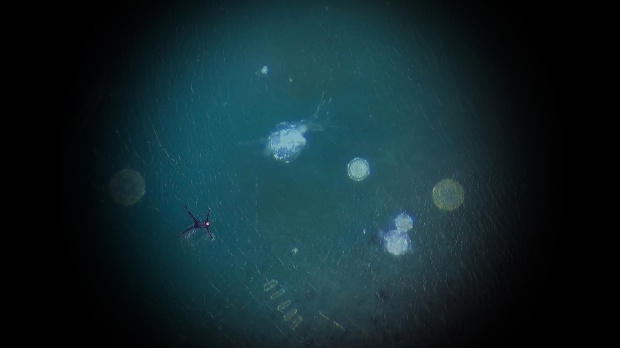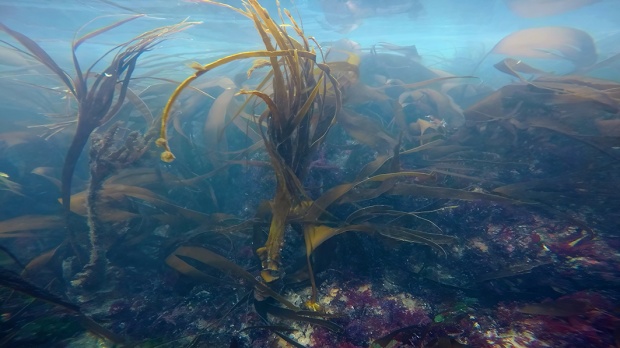
Invisible becomes visible, film still
Solomon gallery 29th may – 21 June 2025
Essay by Cliodhna Shaffrey, Director, Temple Bar Gallery+Studios, Dublin
What it seems it is and in such seeming all things are
Wallace Stevens[i]
I wonder when was the first time Rachel went down to Lough Hyne, and when did she notice the Lake’s irregular rhythm? Surely the sea urchins and mussels who live in these salty waters would have grabbed her attention. This skilled artist has always been drawn to underwater life and the micro elements of the natural world. Her scaled and exquisite sculptures bear their presence as isolates. Rachel’s bronze versions revel in her abilities to bring out the sensual qualities of her material; those calcareous nipply shells, those pearly dark surfaces. She gives us forms we can look inside and peer right through. She wants to bring us close. Utterly approachable, we cannot contain our human foolishness to anthropomorphise. She wants us to see, to really see, the marvel that is there. This is work of compassion. Transfixing invisible entities as objects of substance, so as to bear fruit to her argument that we are knitted into complex biological systems. We are nature, not separate from it.
Artists sometimes speak of their secret sense – the thing that draws them to something. A something outside of themselves that reflects something inside of themselves. We might call this simply paying attention, but it is more than noticing (although that is a primary part of it); it’s an empathy, a need to grasp and create and bring the force or the fury into view. It is Lough Hyne’s intertidal irregular rhythm that beckoned, this time, the point in which her work, Fathom, outstretched arms, is hinged. This is a new path, there is a sense of a turning. There is the continuing subject of anemones and molluscs and the puzzling inhabitants of Lough Hyne who exist because it is sea, river and lake all at once. It’s an extraordinary place, scientists long ago set up a station, and ground-breaking ecological research takes place on its shores. Rachel has walked there umpteen times. Halted, this one day by its unusual cycle, watching the kink between ebb and flow. The precise moment at the turn of the tide. The single spot at which you can see it happen. Hear the swish, a moment of pause, and then the ground-swirl of shallow water over rocks. The air, perhaps, latent with thousands of translucent species. Eight hours to four, (not six to six). Tide in, tide out. Like the breathing exercise they promote to expel pain, awaken senses, imagine ourselves being gently re-fitted into the world, where the question, ‘who am I’ dissolves into a bigger picture – the infinitesimal, cyclical, fleeting. The conundrum, as Rachel declares it, ‘to know an ungraspable thing’.[ii]
Fathom: outstretched arms is the title settled on for this exhibition. Its different meanings potently suggestive. It conjures the spatial and the bodily. It is a system of measurement, generally in relation to the depth of water, and, a puzzle, something to be figured out, fathomed. Outstretched arms brings quick to mind images of an embrace, an opening up to, an invitation towards. Threads tie meanings together in this new body of work. There is a different slant. There is the extension out to others; invitations to collaborate; an embrace of new skills Scientists consulted. A poet’s (Kerry Hardie) words are planted. New processes tried. There is a step into moving image; a revisiting of print; trialling the technique of liquid marbling, and an innovation of cut-off plastic bottle ends for casting bronzes. Delightful are the breakthroughs achieved. Meanings possess layers. It is not so much a divergence from what her art has always been about, charged with wonder for complex interconnectedness at the root of life. Rather, it’s like her art grows new branches. A flowering that holds lightness, as she strives to comprehend a place and crosses the misty boundary that sees the self in a vast and shifting world.
I visit her studio at the foothills of the Blackstairs Mountains. At her kitchen table, we talk about things she has been reflecting on, and how the sharing of books and conversations with Kerry led her to some interesting finds. Significant was Adam Nicholson’s book, The Sea is not Made of Water, whose dive into life between the tides explores the physics of the sea and our human relationship with it. And she is keen to talk about Leonardo’s ‘Vitruvian Man’, the famous Renaissance drawing that epitomises the concept of an ideal ratio of human proportion. A male nude stands in both a circle and a square with two pairs of arms and legs in superimposed positions so they touch the perimeters of both the circle and the square. Rachel has always been fascinated by mathematical patterning – the golden ratio, the Fibonacci series, the rules governing systems. Da Vinci’s drawing speaks to her with its openness to meaning and pushes beyond calculating a formula for the ideal proportion of man at the centre of the universe, suggesting an alternative expression of human diversity. It symbolises different aspects of the universe and our human place within – the circle representing the infinite, the sphere of the divine and the feminine; the square, the material world and the masculine. Might it be possible, Rachel proposes, that Leonardo intended there to be a figure of a woman beneath the superimposed male nude? It’s beguiling.
Outside in her studio, a spacious corrugated barn, I get to see her work in train. There are finished pieces displayed on plinths. A white bronze sea urchin is instantly striking. It commands the voluminous studio in spite of being just the size of a human head. It will set a vantage point for viewing the exhibition. Through a hole at its centre we can look inside and right through to glimpse a group of delicate, perforated cast diatoms (microscopic algae, specific to Lough Hyne). A large mollusc elevated on a tall plinth and the size of a human lung is also ready for the foundry. Its modulated shell hinges open to let us see inside – an intricate bronchial inlay like a strangle of branches. On a table are a series of starfish. Their shapes resonate something of ‘Vitruvian Man’. They will balance on one arm, their spiny surfaces angle into the room and form a line so their collective impact reads like a dance. Plinths of differing heights, capped by a cushion of polished granite for the sculptures to sit on, also perform their part. It is possible to imagine the rhythmic dazzle achieved by this scenario. It wants to take us out of ourselves and into another realm.
Her three moving image works compound this affinity to something bigger. In one, she drops a camera into Lough Hyne at the point of the turning tide. Clusters of seaweed are made to sway back and forth at an unusual, effortless pace. Tendrils, free and easy go this way and then that, and the sun’s radiance pierces the lake’s surface so under the water the colours are blue and pink, purple and green. The sound of the artist breathing, four in, six out, keeps with this beat. Engaging her son’s filmic skills, Rachel floats like a starfish on the Lake, filmed from high above, distance is accentuated and her scale diminished. She is free, she lets go. Footage of the scientist examining diatoms through her microscope is superimposed and their pale spirits swim over and around. Untethered, the self is on a par with the microscopic. We are part of a whole and the whole is vast and mutable and marvellous. The final film is Kerry Hardie’s poem, looped and cyclical so we cannot know its beginning or end. It takes us on a journey from light to dark to light, into time and before time, ‘when nothing was anything, having no I-ness’.
I say goodbye to Rachel and get
on the train to go home. And I write these words, Rachel is an artist true to
herself.
[i] Wallace Stevens, Description Without Place, 1945
[ii] Rachel was referring to Steve Mentz who uses this phrase in his book, At the Bottom of Shakespeare’s Ocean, where he writes about the ocean’s inherent mystery and its challenge to human understanding, The sea possess a complex and dynamic nature that is difficult to fully grasp.
Cliodhna Shaffrey, Director, Temple Bar Gallery+Studios, Dublin
BREATH 4:8. film still

